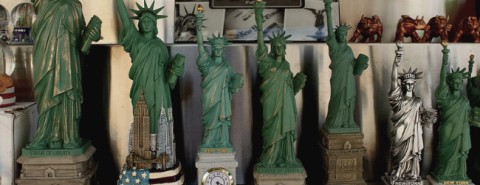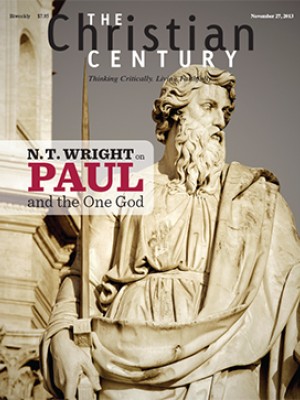Hallowed ground: My civil religion vacation
The carnival barker atmosphere that greeted us outside Manhattan’s South Ferry subway station was, unexpectedly, just what we’d been looking for. Guides in blue shirts sought to usher my family this way or that toward some more profitable version of the Statue of Liberty experience. A half-dozen kiosks offered us their immodestly priced wares as we wended our way through Battery Park toward the ferry.
We were immune to the commercial blandishments. But we found the hustle and bustle oddly charming. We live in the parsonage of the Lutheran church where I serve as a pastor, and this provides us with all the high-mindedness and meaning we could ask for. Soren, my five-year-old, seems to enjoy the heroic swirl of prophets, apostles, saints and sacraments in which he passes so much of his life. He bows toward the altar when we’re in the sanctuary, and he teaches his friends to dip their fingers in the font and mark a cross on their foreheads.
Read our latest issue or browse back issues.
But I can’t help worrying that all that reverence will one day be too much. What our summer vacation needed was a place like South Ferry, where the air was fresh and crass and unconsecrated and where the daily impulse to be decent of language and purposeful of action was a thousand miles away.
After arriving in New York and settling in with our friends on Long Island, we went right to the statue—a national destination commemorated in a tidal wave of paperweights, snow globes and foam crowns. On the ferry, I chattered away about the statue. Soren seized on the detail of the broken chain on Liberty’s foot. Why was she in chains?
I found myself describing slavery to a child I had rather hoped to keep innocent of that institution for a while longer. When we arrived, we slowly circled the whole immensity of the thing while he absorbed the audio tour more attentively than I. Where was the broken chain? He insisted on seeing it. Thankfully, a placard showed us details invisible from our ground-level perspective. There were her chains.
At Hyde Park we visited the Franklin Roosevelt home and library. My son loves presidents, and FDR had by this time become a recurring character in our travels, coming up whenever we crossed a bridge built by Robert Moses. Soren interpreted both men as superheroes, more or less.
We saw the library’s Hooverville tableaux. (“Was everybody dead?” Soren asked. “No, but they were very poor.”) We saw the “Chimes of Normandy” carving, sent to Roosevelt by Ernestine Guerrero of San Antonio. She had made it, over the course of a year, from old relief grocery boxes her father had received at the bottom of the Depression. Guerrero wrote,
I know that you have many pretty things, but please accept and keep this piece of work from a poor girl that doesn’t have anything, also to show you how much we admire you, not only as President of the United States but as a man of great ideals and a big heart toward humanity.
A photo taken on the day after FDR’s death at his retreat in Warm Springs, Georgia, shows the presidential casket and color guard being saluted a final time by two rows of guests in wheelchairs—a stunning witness to Roosevelt’s long advocacy for young people with disabilities.
After decamping from New York for Washington, my family opted to stay behind while I went to the Gettysburg battlefield with my uncle. The first thing I noticed were the monuments. Gettysburg may be the most religious place in America—more charged with sacrifice and meaning than the National Cathedral, more reverently impressive than any Rocky Mountain sunset. It is like a Gothic basilica in the open air, each regimental marker and state-sponsored memorial an altar at which gratitude and praise may be offered.
I sought out the stelae of the Iron Brigade regiments. This midwestern cohort, led by the 2nd Wisconsin, was disbanded after heavy losses at Gettysburg, where it desperately slowed the Confederate advance on the battle’s first day. The 20th Maine is remembered in the woods near the foot of Little Round Top, where it held off a crushing attack on the Union flank on day two. And the 1st Minnesota, sent in to fill a gap in the Union line on the third day, is witnessed by a tall, un-Minnesotan statue of a racing infantryman on Cemetery Ridge.
“We cannot dedicate, we cannot consecrate, we cannot hallow this ground,” said Lincoln, in a gentle rebuke to the shrines that were about to be built. The place of his address is marked by a mammoth column—the sort of monument that, in the true fashion of religion, tries to capture the illumination of a moment by building masonry to a great height. “Those brave men, living and dead, who struggled here, have consecrated it, far above our poor power to add or detract.”
This is religious language. It echoes. We had just seen a facsimile of Roosevelt’s first inaugural address. At the top of the typed manuscript he penciled in an introduction: “This is a day of consecration.” A couple hundred words later is this typed line: “Plenty is at our doorstep”—even in the Depression—“but a vast use of it languishes.” Here Roosevelt crossed out vast and penciled in generous. In one flick of the wrist, he traded the modern language of industrial production for an Old Testament idiom of liberality in the face of need. Sanctity, I saw, was harder to escape than I had expected.
Christians have always had a complicated relationship with nations and with the whole project of peace and prosperity. St. Augustine, whose biography I happened to be reading at the time, understood the peace of the Roman Empire as ultimately false when measured against the peace of the City of God. People in my line of work have always struggled to remind our patriotic faithful that the nation, however great, is not to be worshiped. We have imagined that Christianity embodies something both below the nation, in the poor and marginal who have always been left out of the great stories, and above the nation in virtues and hopes that civil religion cannot produce or explain.
Lincoln would later be reasonably accused of making the nation into a sort of church. Augustine’s earth was hallowed by the martyrs, while Lincoln’s ground was consecrated by the soldiers who strove for a new birth of freedom.
And yet the bone-deep longings and halfway triumphs of our own bloody national history are not lightly transcended, as one might move from Billy Joel to Chopin. The breaking of chains, literal and figurative, is an event full of religious meaning—as both Old and New Testament insist. The wall-sized painting of Washington crossing the Delaware—“Whoa,” my son said when we came into its gallery at the Met—is grandiose and inaccurate in the manner of any icon. Which is to say that it is trying to express a truth that goes deeper than appearances.
In taking this trip with my family, I was trying to escape briefly my own hallowed piece of earth and my own high-minded vocation. Instead we found ourselves on ground littered with relics, hallowed with a liberal mixture of blood—and alive with all the memory and meaning we could bear.






